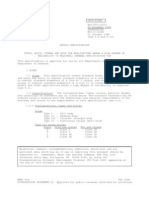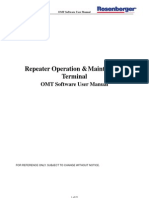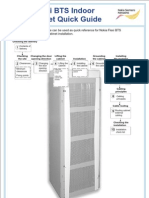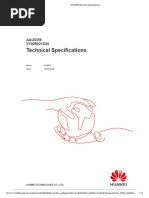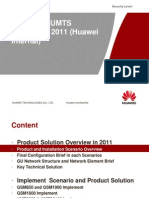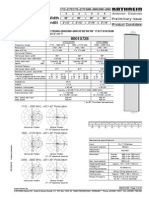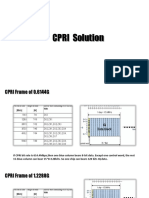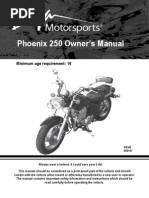MRFUD
MRFUD
Uploaded by
Fatwa RafiudinCopyright:
Available Formats
MRFUD
MRFUD
Uploaded by
Fatwa RafiudinCopyright
Available Formats
Share this document
Did you find this document useful?
Is this content inappropriate?
Copyright:
Available Formats
MRFUD
MRFUD
Uploaded by
Fatwa RafiudinCopyright:
Available Formats
MRFUd Description
Issue
V1.5
Date
2013-01-14
HUAWEI TECHNOLOGIES CO., LTD.
Copyright Huawei Technologies Co., Ltd. 2013. All rights reserved.
No part of this document may be reproduced or transmitted in any form or by any means without prior
written consent of Huawei Technologies Co., Ltd.
Trademarks and Permissions
and other Huawei trademarks are trademarks of Huawei Technologies Co., Ltd.
All other trademarks and trade names mentioned in this document are the property of their respective
holders.
Notice
The purchased products, services and features are stipulated by the contract made between Huawei and
the customer. All or part of the products, services and features described in this document may not be
within the purchase scope or the usage scope. Unless otherwise specified in the contract, all statements,
information, and recommendations in this document are provided "AS IS" without warranties, guarantees or
representations of any kind, either express or implied.
The information in this document is subject to change without notice. Every effort has been made in the
preparation of this document to ensure accuracy of the contents, but all statements, information, and
recommendations in this document do not constitute a warranty of any kind, express or implied.
Huawei Technologies Co., Ltd.
Address:
Huawei Industrial Base
Bantian, Longgang
Shenzhen 518129
People's Republic of China
Website:
http://www.huawei.com
Email:
support@huawei.com
IssueV1.5(2013-01-14)
Huawei Proprietary and Confidential
Copyright Huawei Technologies Co., Ltd
MRFUd Description
Contents
Contents
1 Introduction.................................................................................................................................... 1
1.1 Appearance ....................................................................................................................................................... 1
1.2 Physical Ports ................................................................................................................................................... 2
2 Technical Specifications .............................................................................................................. 3
2.1 Frequency Band ............................................................................................................................................... 3
2.2 Capacity ........................................................................................................................................................... 3
2.3 Receiver Sensitivity ......................................................................................................................................... 4
2.4 Output Power ................................................................................................................................................... 5
2.5 Power Consumption ....................................................................................................................................... 10
2.5.1 Power Consumption of the BTS3900 ................................................................................................... 10
2.5.2 Power Consumption of the BTS3900L ................................................................................................. 12
2.5.3 Power Consumption of the BTS3900A ................................................................................................. 13
3 Acronyms and Abbreviations ................................................................................................... 16
IssueV1.5(2013-01-14)
Huawei Proprietary and Confidential
Copyright Huawei Technologies Co., Ltd
MRFUd Description
1 Introduction
Introduction
The MRFUd can be used in a BTS3900 (Ver.C), BTS3900 (Ver.D) , BTS3900L (Ver.C),
BTS3900L (Ver.D), BTS3900A (Ver.C), BTS3900A (Ver.D) or BTS3900AL cabinet. The
MRFUd performs modulation, demodulation, data processing, and combination and division
of baseband signals and RF signals. With the Software Defined Radio (SDR) technology, the
MRFUd can work either in GU or GL dual-mode through software configuration
modification.
MRFUd has a dual-transmitter and dual-receiver structure, which supports higher output
power and carrier capacity.
1.1 Appearance
Figure 1-1 shows the appearance of the MRFUd.
Figure 1-1 Appearance of the MRFUd
IssueV1.5(2013-01-14)
Huawei Proprietary and Confidential
Copyright Huawei Technologies Co., Ltd
MRFUd Description
1 Introduction
1.2 Physical Ports
Table 1-1 shows the physical ports on the MRFUd.
Table 1-1 Physical ports on the MRFUd
Port
Connector
Quantity
Function
RF port
DIN
Connects to an antenna
Interconnection port
for receiving RF
signals
QMA female
Connects to the another RF
module
Common public
radio interface
(CPRI) port
SFP female
Connects to the baseband
unit (BBU3900)
Power supply socket
3V3
Receives -48 V DC power
MON port
RJ45
Port for monitoring and
maintenance
A BBU3900 and MRFUd are connected through a CPRI port using an electrical or optical
cable to transmit CPRI signals.
The BBU3900 and the MRFUd are connected in dual-star topology. In this topology, the
CPRI port on the GTMU or UBRI is connected to CPRI0 on the MRFUd, and the CPRI port
on the WBBP or LBBP is connected to CPRI1 on the MRFUd, as shown in Figure 1-2.
Figure 1-2 Dual-star topology
IssueV1.5(2013-01-14)
Huawei Proprietary and Confidential
Copyright Huawei Technologies Co., Ltd
MRFUd Description
2 Technical Specifications
Technical Specifications
2.1 Frequency Band
Table 2-1 MRFUd frequency band
Frequency
Band (MHz)
RX Frequency Band (MHz)
TX Frequency Band (MHz)
900
880915
925960
890915
935960
17101785
1805880
1800
2.2 Capacity
Table 2-2 Single-mode capacity
Mode
Capacity
GSM
Each MRFUd supports 8 TRXs.
UMTS
Each MRFUd supports:
LTE
Non-MIMO: 6 carriers
MIMO: 4 carriers
Each MRFUd supports 2 carriers. The LTE bandwidth is 1.4, 3, 5, 10, 15,
or 20 MHz.
Table 2-3 Dual-mode capacity
Mode
Capacity
GSM + UMTS
For detailed specifications, see Table 2-6 and Table 2-7.
GSM + LTE
For detailed specifications, see Table 2-8.
IssueV1.5(2013-01-14)
Huawei Proprietary and Confidential
Copyright Huawei Technologies Co., Ltd
MRFUd Description
2 Technical Specifications
2.3 Receiver Sensitivity
Table 2-4 MRFUd receiver sensitivity
Mode
Frequency
Band (MHz)
1-Way Receiver
Sensitivity
(dBm)
2-Way Receiver
Sensitivity
(dBm)
4-Way Receiver
Sensitivity
(dBm)
GSM
900
-113.7
-116.5
-119.2 (theoretical
value)
1800
-114
-116.8
-119.5 (theoretical
value)
900
-125.8
-128.6
-131.3
1800
-126.1
-128.9
-131.6
900
-106.3
-109.1
-111.8
1800
-106.6
-109.4
-112.1
UMTS
LTE
IssueV1.5(2013-01-14)
Huawei Proprietary and Confidential
Copyright Huawei Technologies Co., Ltd
MRFUd Description
2 Technical Specifications
The receiver sensitivity of GSM, as recommended in 3GPP TS 51.021, is measured in the central
band (80% of the entire operating band, excluding the edge band) at the antenna connector on the
condition that the channel rate is 13 kbit/s and the Bit Error Rate (BER) is not higher than 2%.
The receiver sensitivity of UMTS, as recommended in 3GPP TS 25.104, is measured in the entire
operating band at the antenna connector on the condition that the channel rate is 12.2 kbit/s and the
BER is not higher than 0.001.
The receiver sensitivity of LTE is measured, as recommended in 3GPP TS 36.104, under a 5 MHz
channel bandwidth based on the FRC A1-3 in Annex A.1 (QPSK, R = 1/3, 25 RBs) standard.
2.4 Output Power
MRFUd modules operating in GSM mode and in the 900 or 1800 MHz frequency band comply with
the standard EN 301 502 V9.2.1.
MRFUd modules operating in UMTS, LTE, or Multi-Standard Radio (MSR) mode and in 900 or
1800 MHz frequency band comply with the standard ETSI EN 301 908 V5.2.1 and 3GPP TS
37.104.
For the MRFUd working in GSM mode: when the S1 or S2 configuration is applied, the maximum
output power of each carrier on the MRFUd is 80 W. If the output power of 60 W or 80 W is
required, the related license must be obtained. After design optimization, the 8PSK and GMSK
modulation schemes enable the same output power for each carrier on the MRFUd when any of the
S1 through S6 configurations is used. When the S7 or S8 configuration is used, the license
controlling the GBFD-118104 Enhanced EDGE Coverage feature must be obtained. Otherwise, the
8PSK and GMSK modulation schemes cannot enable the same output power for each carrier on the
MRFUd.
The output power is 1 dB lesser than the standard power when the MRFUd is located at a height of
3500 m to 4500m; and is 2 dB lesser than the standard power when the MRFUd is located at a height
of 4500 m to 6000m.
Factors such as the site-to-site distance, frequency-reuse factor, power control algorithm, and traffic
model affect the gain achieved by dynamic power allocation. Therefore, in most cases, the network
planning can be based on the power specification achieved by dynamic power allocation.
In power sharing mode, the power control and DTX functions must be enabled. In GBSS8.1, the
dynamic power sharing feature is mutually exclusive with the GBFD-113201 Concentric Cell,
GBFD-114501 Co-BCCH Cell, GBFD-118001 BCCH Dense Frequency Multiplexing, and
GBFD-117501 Enhanced Measurement Report (EMR) features. In GBSS9.0 and later versions, the
dynamic power sharing feature can be used together with these features. However, the dynamic
power sharing feature currently cannot be used together with the GBFD-117002 IBCA (Interference
Based Channel Allocation), GBFD-117001 Flex MAIO, GBFD-118701 RAN Sharing, and
GBFD-114001 Extended Cell features in GBSS8.1, GBSS9.0, and later versions.
Power sharing assumes a random distribution of UEs in the cell.
Table 2-5, Table 2-6, Table 2-7, and Table 2-8 list the typical configurations of the MRFUd.
Table 2-5 Typical MRFUd configuration (900 MHz/1800 MHz, single-mode)
Number
of GSM
Carriers
Number
of UMTS
Carriers
Number
of LTE
Carriers
Output
Power
per
GSM
Carrier
(W)
Output
Sharing
Power
per GSM
Carrier
(W)
Output
Power per
UMTS
Carrier
(W)
Output
Power per
LTE
Carrier
(W)
80
80
IssueV1.5(2013-01-14)
Huawei Proprietary and Confidential
Copyright Huawei Technologies Co., Ltd
MRFUd Description
2 Technical Specifications
Number
of GSM
Carriers
Number
of UMTS
Carriers
Number
of LTE
Carriers
Output
Power
per
GSM
Carrier
(W)
Output
Sharing
Power
per GSM
Carrier
(W)
Output
Power per
UMTS
Carrier
(W)
Output
Power per
LTE
Carrier
(W)
80
80
40
40
40
40
27
30
27
30
20
27
20
27
80
80
40
40
25
25
1 (MIMO)
2 x 40
2 (MIMO)
2 x 40
3 (MIMO)
2 x 25
4 (MIMO)
2 x 20
5/10/15/20
MHz: 2 x
60
1.4/3 MHz:
2 x 40
2 x 40
Table 2-6 Typical MRFUd configuration (900 MHz/1800 MHz, GU Non-MSR)
Number of
GSM Carriers
Number of
UMTS Carriers
Output Power per
GSM Carrier (W)
Output Power per
UMTS Carrier (W)
80
80
40
80
IssueV1.5(2013-01-14)
Huawei Proprietary and Confidential
Copyright Huawei Technologies Co., Ltd
MRFUd Description
2 Technical Specifications
Number of
GSM Carriers
Number of
UMTS Carriers
Output Power per
GSM Carrier (W)
Output Power per
UMTS Carrier (W)
27
80
20
80
16
80
12
80
80
40
40
40
27
40
20
40
16
40
12
40
80
25
40
25
27
25
20
25
16
25
80
20
40
20
27
20
20
20
Table 2-7 Typical MRFUd configuration (900 MHz/1800 MHz, GU MSR)
Number of
GSM Carriers
Number of
UMTS Carriers
Output Power per
GSM Carrier (W)
Output Power per
UMTS Carrier (W)
40
40
40
40
27
40
27
20
25
30
20
40
IssueV1.5(2013-01-14)
Huawei Proprietary and Confidential
Copyright Huawei Technologies Co., Ltd
MRFUd Description
2 Technical Specifications
Number of
GSM Carriers
Number of
UMTS Carriers
Output Power per
GSM Carrier (W)
Output Power per
UMTS Carrier (W)
20
40
20
20
16
30
40
40
40
40
30
20
25
30
20
40
30
20
25
30
20
40
20
20
20
20
1 (MIMO)
40
2 x 40
1 (MIMO)
40
2 x 40
1 (MIMO)
20
2 x 40
1 (MIMO)
25
2 x 30
1 (MIMO)
20
2 x 40
1 (MIMO)
25
2 x 30
1 (MIMO)
30
2 x 20
2 (MIMO)
20
2 x 30
2 (MIMO)
40
2 x 20
2 (MIMO)
20
2 x 30
2 (MIMO)
40
2 x 20
2 (MIMO)
15
2 x 20
2 (MIMO)
15
2 x 20
IssueV1.5(2013-01-14)
Huawei Proprietary and Confidential
Copyright Huawei Technologies Co., Ltd
MRFUd Description
2 Technical Specifications
Table 2-8 Typical MRFUd configuration (900 MHz/1800 MHz, GL MSR)
Number of
GSM Carriers
Number of
LTE Carriers
Output Power per
GSM Carrier (W)
Output Power per LTE
Carrier (W)
1 (MIMO)
40
2 x 40
1 (MIMO)
40
2 x 40
1 (MIMO)
30
2 x 20
1 (MIMO)
25
2 x 30
1 (MIMO)
20
2 x 40
1 (MIMO)
20
2 x 40
1 (MIMO)
25
2 x 30
1 (MIMO)
30
2 x 20
1 (MIMO)
16
2 x 30
1 (MIMO)
20
2 x 20
1 (MIMO)
15
2 x 20
IssueV1.5(2013-01-14)
Huawei Proprietary and Confidential
Copyright Huawei Technologies Co., Ltd
MRFUd Description
2 Technical Specifications
2.5 Power Consumption
The typical power consumption and the maximum power consumption are measured when the base
station works at a temperature of 25C.
The typical power consumption for GSM is reached when the base station works with 30% load and
power control and DTX are enabled. The maximum power consumption for GSM is reached when
the base station works with 100% load.
The typical power consumption for UMTS is reached when the base station works with 40% load.
The maximum power consumption for UMTS is reached when the base station works with 100%
load.
The typical power consumption for LTE is reached when the base station works with 50% load. The
maximum power consumption for LTE is reached when the base station works with 100% load.
LTE power consumption is calculated based on the 2 x 2 MIMO configuration. Two MRFUs are
configured in each sector.
2.5.1 Power Consumption of the BTS3900
Table 2-9 Power consumption of the BTS3900 (Ver.C) (-48V) (configured with MRFUd, 900
MHz)
Mode
Configuration
Output Power
per Carrier (W)
Typical Power
Consumption
(W)
Maximum
Power
Consumption
(W)
GSM
S2/2/2
20
620
715
S4/4/4
20
720
1040
S6/6/6
20
1000
1505
S8/8/8
20
1095
1825
3x1
20
510
570
3x2
20
585
750
LTE
3 x 10 MHz
40
945
1245
GSM +
UMTS
GSM S2/2/2 +
UMTS 3 x 1
GSM: 20
785
965
GSM S3/3/3 +
UMTS 3 x 1
GSM: 20
835
1160
GSM S4/4/4 +
UMTS 3 x 1
GSM: 20
1065
1425
GSM S2/2/2 +
LTE 3 x 10 MHz
GSM: 20
1260
1635
GSM S3/3/3 +
LTE 3 x 10 MHz
GSM: 20
1320
1815
UMTS
GSM +
LTE
IssueV1.5(2013-01-14)
UMTS: 20
UMTS: 20
UMTS: 20
LTE: 40
LTE: 40
Huawei Proprietary and Confidential
Copyright Huawei Technologies Co., Ltd
MRFUd Description
2 Technical Specifications
GSM S4/4/4 +
LTE 3 x 10 MHz
GSM: 20
1380
1995
LTE: 40
Table 2-10 Power consumption of the BTS3900 (Ver.C) (-48V) (configured with MRFUd, 1800
MHz)
Mode
Configuration
Output Power
per Carrier (W)
Typical Power
Consumption
(W)
Maximum
Power
Consumption
(W)
GSM
S2/2/2
20
635
730
S4/4/4
20
735
1060
S6/6/6
20
1030
1540
S8/8/8
20
1130
1860
3x1
20
510
585
3x2
20
600
795
LTE
3 x 10 MHz
40
960
1275
GSM +
UMTS
GSM S2/2/2 +
UMTS 3 x 1
GSM: 20
800
985
GSM S3/3/3 +
UMTS 3 x 1
GSM: 20
850
1180
GSM S4/4/4 +
UMTS 3 x 1
GSM: 20
1090
1455
GSM S2/2/2 +
LTE 3 x 10 MHz
GSM: 20
1365
1755
GSM S3/3/3 +
LTE 3 x 10 MHz
GSM: 20
1410
1920
GSM S4/4/4 +
LTE 3 x 10 MHz
GSM: 20
1425
2070
UMTS
GSM +
LTE
IssueV1.5(2013-01-14)
UMTS: 20
UMTS: 20
UMTS: 20
LTE: 40
LTE: 40
LTE: 40
Huawei Proprietary and Confidential
Copyright Huawei Technologies Co., Ltd
MRFUd Description
2 Technical Specifications
2.5.2 Power Consumption of the BTS3900L
Table 2-11 Power consumption of the BTS3900L (Ver.C) (configured with MRFUd, 900 MHz)
Mode
Configuration
Output Power
per Carrier (W)
Typical Power
Consumption
(W)
Maximum
Power
Consumption
(W)
GSM
S2/2/2
20
650
755
S4/4/4
20
800
1145
S6/6/6
20
1025
1610
S8/8/8
20
1130
1910
3x1
20
540
600
3x2
20
615
780
LTE
3 x 10 MHz
40
975
1275
GSM +
UMTS
GSM S2/2/2 +
UMTS 3 x 1
GSM: 20
850
1045
GSM S3/3/3 +
UMTS 3 x 1
GSM: 20
895
1195
GSM S4/4/4 +
UMTS 3 x 1
GSM: 20
1075
1480
GSM S2/2/2 +
LTE 3 x 10 MHz
GSM: 20
1290
1665
GSM S3/3/3 +
LTE 3 x 10 MHz
GSM: 20
1350
1845
GSM S4/4/4 +
LTE 3 x 10 MHz
GSM: 20
1410
2025
UMTS
GSM +
LTE
UMTS: 20
UMTS: 20
UMTS: 20
LTE: 40
LTE: 40
LTE: 40
Table 2-12 Power consumption of the BTS3900L (Ver.C) (configured with MRFUd, 1800 MHz)
Mode
Configuration
Output Power
per Carrier (W)
Typical Power
Consumption
(W)
Maximum
Power
Consumption
(W)
GSM
S2/2/2
20
650
770
S4/4/4
20
800
1160
S6/6/6
20
1115
1640
IssueV1.5(2013-01-14)
Huawei Proprietary and Confidential
Copyright Huawei Technologies Co., Ltd
MRFUd Description
2 Technical Specifications
S8/8/8
20
1145
1985
3x1
20
540
615
3x2
20
630
825
LTE
3 x 10 MHz
40
990
1305
GSM +
UMTS
GSM S2/2/2 +
UMTS 3 x 1
GSM: 20
865
1060
GSM S3/3/3 +
UMTS 3 x 1
GSM: 20
910
1225
GSM S4/4/4 +
UMTS 3 x 1
GSM: 20
1075
1480
GSM S2/2/2 +
LTE 3 x 10 MHz
GSM: 20
1395
1785
GSM S3/3/3 +
LTE 3 x 10 MHz
GSM: 20
1440
1950
GSM S4/4/4 +
LTE 3 x 10 MHz
GSM: 20
1455
2100
UMTS
GSM +
LTE
UMTS: 20
UMTS: 20
UMTS: 20
LTE: 40
LTE: 40
LTE: 40
2.5.3 Power Consumption of the BTS3900A
Table 2-13 Power consumption of the BTS3900A (Ver.C) (-48V) (configured with MRFUd, 900
MHz)
Mode
Configuration
Output Power
per Carrier (W)
Typical Power
Consumption
(W)
Maximum
Power
Consumption
(W)
GSM
S2/2/2
20
650
755
S4/4/4
20
800
1145
S6/6/6
20
1025
1610
S8/8/8
20
1130
1910
3x1
20
540
600
3x2
20
615
780
LTE
3 x 10 MHz
40
975
1275
GSM +
UMTS
GSM S2/2/2 +
UMTS 3 x 1
GSM: 20
850
1045
UMTS
IssueV1.5(2013-01-14)
UMTS: 20
Huawei Proprietary and Confidential
Copyright Huawei Technologies Co., Ltd
MRFUd Description
2 Technical Specifications
Mode
GSM +
LTE
Configuration
Output Power
per Carrier (W)
Typical Power
Consumption
(W)
Maximum
Power
Consumption
(W)
GSM S3/3/3 +
UMTS 3 x 1
GSM: 20
895
1195
GSM S4/4/4 +
UMTS 3 x 1
GSM: 20
1075
1480
GSM S2/2/2 +
LTE 3 x 10 MHz
GSM: 20
1290
1665
GSM S3/3/3 +
LTE 3 x 10 MHz
GSM: 20
1350
1845
GSM S4/4/4 +
LTE 3 x 10 MHz
GSM: 20
1410
2025
UMTS: 20
UMTS: 20
LTE: 40
LTE: 40
LTE: 40
Table 2-14 Power consumption of the BTS3900A (Ver.C) (-48V) (configured with MRFUd, 1800
MHz)
Mode
Configuration
Output Power
per Carrier (W)
Typical Power
Consumption
(W)
Maximum
Power
Consumption
(W)
GSM
S2/2/2
20
650
770
S4/4/4
20
800
1160
S6/6/6
20
1115
1640
S8/8/8
20
1145
1985
3x1
20
540
615
3x2
20
630
825
LTE
3 x 10 MHz
40
990
1305
GSM +
UMTS
GSM S2/2/2 +
UMTS 3 x 1
GSM: 20
865
1060
GSM S3/3/3 +
UMTS 3 x 1
GSM: 20
910
1225
GSM S4/4/4 +
UMTS 3 x 1
GSM: 20
1075
1480
GSM S2/2/2 +
LTE 3 x 10 MHz
GSM: 20
1395
1785
UMTS
GSM +
LTE
IssueV1.5(2013-01-14)
UMTS: 20
UMTS: 20
UMTS: 20
LTE: 40
Huawei Proprietary and Confidential
Copyright Huawei Technologies Co., Ltd
MRFUd Description
IssueV1.5(2013-01-14)
2 Technical Specifications
GSM S3/3/3 +
LTE 3 x 10 MHz
GSM: 20
GSM S4/4/4 +
LTE 3 x 10 MHz
GSM: 20
1440
1950
1455
2100
LTE: 40
LTE: 40
Huawei Proprietary and Confidential
Copyright Huawei Technologies Co., Ltd
MRFUd Description
3 Acronyms and Abbreviations
Acronyms and Abbreviations
Abbreviation
Full Name
3GPP
3rd Generation Partnership Project
BBU
Baseband Unit
BER
Bit Error Ratio
CPRI
Common Public Radio Interface
DTX
Discontinuous Transmission
GSM
Global Service Mobile
GTMU
GSM Timing and Main Control Unit
LBBP
LTE BaseBand Processing Unit
LTE
Long Term Evolution
MIMO
Multi-input and Multi-output
MSR
Multi-Standard Radio
MRFUd
Multi-Mode Radio Frequency Unit
RAN
Radio Access Network
SDR
Software Defined Radio
UBRI
Universal Baseband Radio Interference Board
UMTS
Universal Mobile Telecommunications System
WBBP
WCDMA Baseband Processing unit
IssueV1.5(2013-01-14)
Huawei Proprietary and Confidential
Copyright Huawei Technologies Co., Ltd
You might also like
- AS 1170.4 (2024)Document56 pagesAS 1170.4 (2024)75pastNo ratings yet
- Pallet Jack Safety TrainingDocument21 pagesPallet Jack Safety TrainingIndranil Mitra100% (2)
- Mil DTL 1222jDocument51 pagesMil DTL 1222jwmish7419No ratings yet
- Autodesk Subassembly ComposerDocument57 pagesAutodesk Subassembly ComposerEdz JustoNo ratings yet
- Rosenberger OMT Software User ManualDocument19 pagesRosenberger OMT Software User ManualTien Anh100% (2)
- LampSite InstallationDocument12 pagesLampSite InstallationJoelMalangNo ratings yet
- User Manual: Huawei Technologies Co., LTDDocument47 pagesUser Manual: Huawei Technologies Co., LTDMerab KvitsaridzeNo ratings yet
- Understanding The Principles and Practices of Assessment: D/601/5313 VRQ UV30563Document20 pagesUnderstanding The Principles and Practices of Assessment: D/601/5313 VRQ UV30563حيدرالركابي100% (1)
- RRU3928 Description V1.2Document15 pagesRRU3928 Description V1.2c2poyraz100% (2)
- MRFU DescriptionDocument21 pagesMRFU Descriptionerginbekar100% (2)
- MRFU DescriptionDocument18 pagesMRFU DescriptionSamirTam100% (1)
- RRU3939 DescriptionDocument13 pagesRRU3939 Descriptionerginbekar100% (3)
- RRU3965&RRU3965d Description: Huawei Technologies Co., LTDDocument22 pagesRRU3965&RRU3965d Description: Huawei Technologies Co., LTDercanaktas100% (2)
- Radio Spectrum Management: Policies, Regulations and TechniquesFrom EverandRadio Spectrum Management: Policies, Regulations and TechniquesNo ratings yet
- Radio Network Planning and Optimisation for UMTSFrom EverandRadio Network Planning and Optimisation for UMTSJaana LaihoRating: 4.5 out of 5 stars4.5/5 (2)
- Flexi Remote Radio Head 2TX 900Document5 pagesFlexi Remote Radio Head 2TX 900Reza BordbarNo ratings yet
- RRU5508 (700Mhz + 850Mhz) - Technical SpecificationsDocument15 pagesRRU5508 (700Mhz + 850Mhz) - Technical SpecificationsshlolloNo ratings yet
- RRUDocument9 pagesRRUsamNo ratings yet
- Site Soluton Battle 2Document43 pagesSite Soluton Battle 2maulana habibieNo ratings yet
- RRU5502 DescriptionDocument40 pagesRRU5502 DescriptionMauricioNo ratings yet
- RRU3668 Hardware Description (05) (PDF) - en PDFDocument42 pagesRRU3668 Hardware Description (05) (PDF) - en PDFJaime Yarihuaman QuispeNo ratings yet
- Flexi RF Module 3TX 2100 : Technical SpecificationsDocument10 pagesFlexi RF Module 3TX 2100 : Technical SpecificationsReza BordbarNo ratings yet
- RRU3004 Description V1.3Document9 pagesRRU3004 Description V1.3Lutfi ArifNo ratings yet
- Study On UMTSLTE in 900 MHZ Band and Coexistence With 850 MHZ BandDocument34 pagesStudy On UMTSLTE in 900 MHZ Band and Coexistence With 850 MHZ BandMuhammad Jamil AwanNo ratings yet
- FTIF Transport PDH / Ethernet: Support of TDM Interfaces and Extended Ethernet ConnectivityDocument1 pageFTIF Transport PDH / Ethernet: Support of TDM Interfaces and Extended Ethernet ConnectivityReza BordbarNo ratings yet
- Flexible User Steering (ERAN3.0 - 01)Document81 pagesFlexible User Steering (ERAN3.0 - 01)AlexNo ratings yet
- FCIA Quick GuideDocument11 pagesFCIA Quick GuideArman IraniNo ratings yet
- FXEFDocument5 pagesFXEFReza BordbarNo ratings yet
- Flexi RRH 2-Pipe 2100 120 W (FRGY)Document4 pagesFlexi RRH 2-Pipe 2100 120 W (FRGY)Andrei GhitiuNo ratings yet
- RRU3929 Description: Huawei Technologies Co., LTDDocument15 pagesRRU3929 Description: Huawei Technologies Co., LTDDocMasterNo ratings yet
- Power Configuration Rru 161Document1,917 pagesPower Configuration Rru 161SemirNo ratings yet
- Huawei TMA SupportDocument33 pagesHuawei TMA SupportSathorn TumNo ratings yet
- RRU5904 Description: Huawei Technologies Co., LTDDocument16 pagesRRU5904 Description: Huawei Technologies Co., LTD'Theodora GeorgianaNo ratings yet
- Power Your Signal: Antenna SpecificationsDocument3 pagesPower Your Signal: Antenna SpecificationsДмитрийNo ratings yet
- Rru 4466Document28 pagesRru 4466ckiljaNo ratings yet
- Site Installation Overview V1.0 20131021 - LabelDocument1 pageSite Installation Overview V1.0 20131021 - LabelOussama VernalNo ratings yet
- MINI-LINK PT 2020 Datasheet PDFDocument2 pagesMINI-LINK PT 2020 Datasheet PDFHossein HosseinpourNo ratings yet
- MRFUd Power ConfigurationDocument20 pagesMRFUd Power ConfigurationsamNo ratings yet
- 05 6275 Hspa E01 KH MoDocument136 pages05 6275 Hspa E01 KH MoamirNo ratings yet
- Mjs Odv065r15jj BR Ds 0 4 2Document2 pagesMjs Odv065r15jj BR Ds 0 4 2Claudio Eduardo Mosquera BravoNo ratings yet
- Ultra Compact Width: 12-Port Antenna Frequency Range Dual Polarization HPBW Gain Adjust. Electr. DTDocument13 pagesUltra Compact Width: 12-Port Antenna Frequency Range Dual Polarization HPBW Gain Adjust. Electr. DTlucafrugantiNo ratings yet
- Datasheet 78211000 PDFDocument1 pageDatasheet 78211000 PDFnasty_plusNo ratings yet
- RRU3008 Description V1.3Document11 pagesRRU3008 Description V1.3Anang PrasetyoNo ratings yet
- SC4812T Lite 800 MHZ BTS Data SheetDocument2 pagesSC4812T Lite 800 MHZ BTS Data SheetWayne ChuNo ratings yet
- Rrus HuaweiDocument35 pagesRrus HuaweiAlejandroPortuguezTapiaNo ratings yet
- RRU3965&RRU3965d Description: Huawei Technologies Co., LTDDocument22 pagesRRU3965&RRU3965d Description: Huawei Technologies Co., LTDAlex PereiraNo ratings yet
- AAU5356Document17 pagesAAU5356kagbeykaracaNo ratings yet
- RNC Hardware Description - (V200R011 - 04)Document214 pagesRNC Hardware Description - (V200R011 - 04)Ku Boss100% (1)
- Configuration RBS2206Document1 pageConfiguration RBS2206Tayo AkinwandeNo ratings yet
- RRU Support RATDocument12 pagesRRU Support RATHuế Đà Nẵng100% (1)
- RBS3216 - NotesDocument14 pagesRBS3216 - NotesMinto IssacNo ratings yet
- VIVO GSM UMTS Solution in 2011 - Huawei Internal V2 (20110120)Document104 pagesVIVO GSM UMTS Solution in 2011 - Huawei Internal V2 (20110120)Carlos AlbertoNo ratings yet
- Gu Der ZXSDR Bs8906 Product Description Ur11.2 v1.02 20120525Document39 pagesGu Der ZXSDR Bs8906 Product Description Ur11.2 v1.02 20120525UmarFarooqNo ratings yet
- RRU Overview: Security Level: InternalDocument25 pagesRRU Overview: Security Level: InternalRyan De LeonNo ratings yet
- 80010728Document2 pages80010728marco100% (1)
- KRC1612228~11~Radio_2271_B28Document4 pagesKRC1612228~11~Radio_2271_B28Ronald NavarroNo ratings yet
- Online Submission of Forms by Private Candidates Comptt. Class X-Xii July 2019Document17 pagesOnline Submission of Forms by Private Candidates Comptt. Class X-Xii July 2019Aditya RajNo ratings yet
- RBS 6501 Installation InstructionsDocument37 pagesRBS 6501 Installation InstructionsLeo DuranNo ratings yet
- ZTE CPRI Solution - V2Document7 pagesZTE CPRI Solution - V2Jonan Kansiime100% (2)
- ZXSDR A8612 (V1.0) Hardware InstallationDocument69 pagesZXSDR A8612 (V1.0) Hardware InstallationАртём ДицNo ratings yet
- ZXUR 9000 GSM Data Configuration GuideDocument136 pagesZXUR 9000 GSM Data Configuration GuidenazilaNo ratings yet
- MRFU Description V1 6Document18 pagesMRFU Description V1 6Thats MyName100% (2)
- Mrfud Description v0.5Document14 pagesMrfud Description v0.5Tarek El DeghedyNo ratings yet
- Rru3908 PDFDocument14 pagesRru3908 PDFGustavo100% (4)
- ABB Surge Arrester GuideDocument96 pagesABB Surge Arrester GuideBhuvanes WaranNo ratings yet
- Materials Selection For Neat Methanol Service FINALDocument11 pagesMaterials Selection For Neat Methanol Service FINALWahyua SatrioNo ratings yet
- Protecting Steam Turbines During ShutdownDocument2 pagesProtecting Steam Turbines During ShutdownAnggya Anggy100% (1)
- Tunnel and Shaft SolutionsDocument48 pagesTunnel and Shaft SolutionsMohamed H. Jiffry100% (4)
- Comparing and Contrasting The KDPA With The GDPRDocument4 pagesComparing and Contrasting The KDPA With The GDPRegidiah15No ratings yet
- Aga 11Document7 pagesAga 11elijbbNo ratings yet
- PMRC$MAR$VA$107 Ball ValvesDocument13 pagesPMRC$MAR$VA$107 Ball ValvesradziNo ratings yet
- 41 OWNERS MANUAL - PX250 Motorcycle Owners Manual VIN Prefix LE8Document71 pages41 OWNERS MANUAL - PX250 Motorcycle Owners Manual VIN Prefix LE8joao falcaoNo ratings yet
- Literature Review On Internal AuditorDocument4 pagesLiterature Review On Internal Auditorfahynavakel2100% (1)
- Multimedia NoteDocument13 pagesMultimedia Noteshadequl islamNo ratings yet
- Process Industry Practices Structural: PIP STE05121 Anchor Bolt Design GuideDocument55 pagesProcess Industry Practices Structural: PIP STE05121 Anchor Bolt Design GuideWNo ratings yet
- 2.4 Solid Fuel Handling SystemDocument29 pages2.4 Solid Fuel Handling SystemNind's Chef100% (1)
- 6 RC Phase ShiftDocument6 pages6 RC Phase ShiftengineerluvNo ratings yet
- TEC-033000 - MET-DoR-PIV-P623 (Cast in Place Concrete For Sub Structures) (C)Document13 pagesTEC-033000 - MET-DoR-PIV-P623 (Cast in Place Concrete For Sub Structures) (C)Haymanot BaynesagnNo ratings yet
- UniGear ZS3.2 Brochure Rev. B EN PDFDocument8 pagesUniGear ZS3.2 Brochure Rev. B EN PDFbpchimeraNo ratings yet
- MasterLine 16 Manual 2019 PDFDocument38 pagesMasterLine 16 Manual 2019 PDFcokavolitangoNo ratings yet
- Internal MobilityDocument14 pagesInternal MobilityNIKNISHNo ratings yet
- Jyothi Nandikonda Supervisor: Olav TirkkonenDocument15 pagesJyothi Nandikonda Supervisor: Olav Tirkkonenarteepu4No ratings yet
- Data SheetDocument5 pagesData SheetAirRey23No ratings yet
- Stress Relieving As Per IS 2825Document4 pagesStress Relieving As Per IS 2825Sudhir DwivediNo ratings yet
- ATT-TP-76200 I17 PDFDocument82 pagesATT-TP-76200 I17 PDFtomscribd18No ratings yet
- Rola Star CatalogueDocument8 pagesRola Star CataloguemaximghNo ratings yet
- TGS en - 81991877562Document422 pagesTGS en - 81991877562Cleverson Jose Godinho100% (2)
- UNI 5587 - 1968thick Hexagon Nuts (Special Purpose) - ISO Metric Coarse and Fine Thread - Finish ADocument9 pagesUNI 5587 - 1968thick Hexagon Nuts (Special Purpose) - ISO Metric Coarse and Fine Thread - Finish ANarimane Benty0% (1)
- ManSafe For Industry (UK)Document8 pagesManSafe For Industry (UK)Ibrahim SahinNo ratings yet


